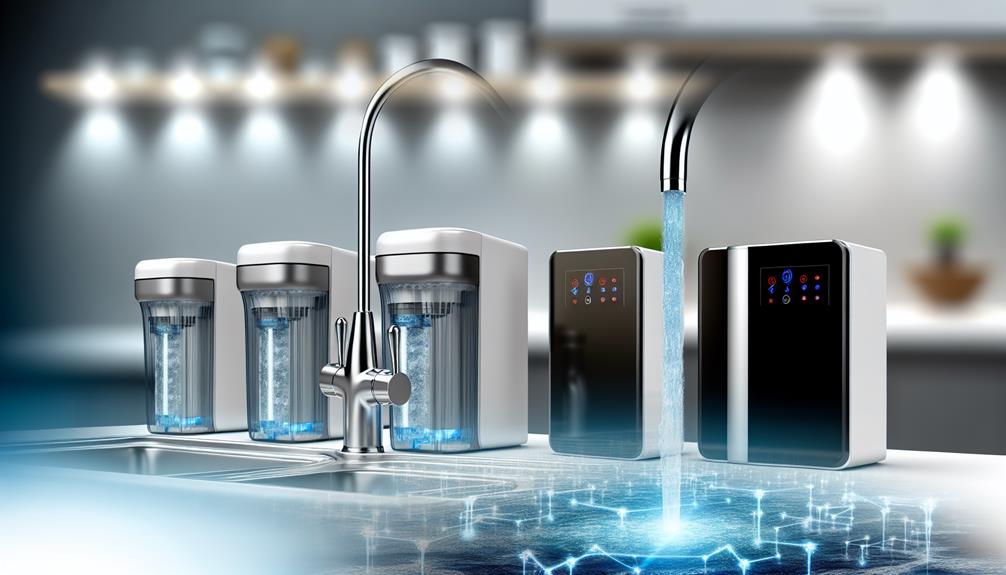Imagine you're in a coastal city where rising sea levels have begun to salinate the groundwater, posing a significant challenge to the existing water filtration systems. As a professional tasked with ensuring a safe water supply, you can't help but recognize the urgency for adaptive strategies that can withstand the impacts of climate change.
It's clear that the old methods won't hold up; saltwater intrusion, increased pollutants from heavy rains, and extreme weather events demand a robust and innovative approach to water filtration.
You might wonder, what cutting-edge solutions and modifications are being explored worldwide to address these pressing issues? With the future of clean water hanging in the balance, it's crucial to explore how communities are transforming their water infrastructure to meet the demands of a rapidly changing climate.
Assessing Climate Risks
To effectively mitigate the effects of climate change on water systems, it's crucial to first pinpoint the potential risks to water sources and infrastructure through comprehensive climate modeling and vulnerability assessments. You, as a water authority, must assess vulnerability with a keen, analytical eye, considering how climate change impacts may cascade through your network. Rising temperatures and extreme weather events, such as floods and droughts, necessitate robust adaptation strategies.
Your infrastructure, including water treatment facilities, must be scrutinized for climate resilience. It's imperative to prioritize risks to ensure that the most urgent and critical issues are addressed with appropriate measures. This may involve investing in advanced water treatment technologies, such as membrane filtration and advanced oxidation processes, to strengthen infrastructure against the variability of water quality.
Additionally, you'll need to look beyond traditional sources and infrastructure. Exploring alternative sources like stormwater management, rainwater harvesting, groundwater recharge, and seawater desalination can diversify your water supply and enhance resilience. Collaborate with stakeholders to raise awareness and adapt collectively.
Infrastructure Resilience Enhancements
Having assessed the climate risks, it's imperative that you now focus on bolstering the resilience of your water infrastructure through strategic enhancements and diversified approaches. Climate change adaptation requires you to protect critical infrastructure, including your Water Treatment Plant for Climate resiliency. This involves constructing flood barriers like levees, dikes, and seawalls, to shield against extreme weather events.
Furthermore, integrating Green Infrastructure to Manage water smartly can reduce the pressure on water treatment systems. Aquifer storage and recovery infrastructure also plays a crucial role in enhancing water supply resilience, particularly during droughts or water shortages.
To ensure continuity of service, diversifying your water sources is essential. Utilize a mix of surface water, groundwater, and desalination to maintain a stable water supply. Incorporating backup power systems is a non-negotiable element in adapting to climate change, ensuring your water utility infrastructure remains operational during power outages.
Lastly, climate risk modeling and monitoring must be an ongoing practice. It informs infrastructure resilience enhancements by providing evidence-based strategies. Collaboration with neighboring utilities and local governments is also key, as it allows for resource sharing and collective response to emergent challenges.
Diversification of Water Sources
Diversifying your water sources is a strategic approach to ensure a robust and reliable water supply in the face of climate change-induced variability. By expanding beyond traditional drinking water sources such as rivers and lakes, you can mitigate the risks associated with decreased surface water flows and increased water demand. The Bay diversifies water sources through innovative methods like rainwater harvesting and stormwater reuse, which can replenish local aquifers and contribute to water storage.
In your water conservation efforts, integrating pricing schemes and metering can discourage wasteful practices, while educational programs raise awareness about the importance of sustainable water use. These strategies aren't only proactive in managing water demand but also vital in safeguarding water resources against unpredictable climatic shifts.
Promoting water recycling and desalination technologies is another crucial step. These processes supplement water supply, especially in coastal areas where the threat of wetlands to storm surge is prevalent. Efficient water treatment systems ensure the safety and usability of these alternative sources.
Adapting water filtration strategies to include climate change resilience measures is key. By embracing a diversified approach, you'll enhance water security and support sustainable water resource management for the future.
Collaborative Adaptation Efforts
While securing a diverse array of water sources bolsters resilience against climate variability, forging partnerships for collaborative adaptation efforts is equally crucial to enhance the robustness of water infrastructure systems. You're not in this alone; the challenges posed by climate change demand a coordinated response. By collaborating with neighboring utilities for mutual aid agreements, you're preparing to share resources during acute crises, ensuring that increased water demand or compromised water quality can be met with a more flexible, supportive approach.
Implementing climate resilience measures involves:
- Participation in community planning and regional collaborations with local and regional governments and organizations.
- Upgrading water treatment strategies to address water quality improvement, including enhanced treatment for pollutants that climate change might exacerbate.
- Developing green infrastructure solutions for stormwater management, such as rain gardens and permeable pavements, to mitigate the impacts of heavy precipitation events.
Technical solutions like saltwater intrusion barriers and aquifer recharge are vital adaptation measures to prevent saltwater intrusion into coastal aquifers. Moreover, improving pumps for backflow prevention is critical for areas facing sea-level rise and coastal storm surges.
These collaborative adaptation efforts are essential for addressing water supply challenges and securing a sustainable, quality water supply amidst the uncertainties of climate change.
Performance Monitoring and Adjustment
To ensure that water filtration systems remain effective under changing climatic conditions, it's essential to establish comprehensive performance monitoring and make timely adjustments. Monitoring data provides invaluable insights into how water temperatures, storm events, and heavy rainfall influence water quality. This data is the backbone of any adaptive management practices aimed at improving water treatment efficacy and ensuring climate resilience.
You must be vigilant in interpreting the impacts of climate change on water filtration performance. For instance, a rise in water temperatures can accelerate microbial growth, necessitating adjustments to disinfection protocols. Similarly, an increase in storm events and heavy rainfall can lead to higher levels of turbidity and pollutants, which may overwhelm standard filtration capacities.
By continuously analyzing monitoring data, you can adapt to changing conditions by implementing more robust filtration media or by adjusting operational parameters such as flow rates and backwash cycles. This proactive approach not only maintains water quality but also extends the lifespan of your infrastructure.
Your goal is to create a dynamic system that responds to environmental feedback and sustains water quality standards amidst the evolving climate landscape. Through meticulous performance monitoring and strategic adjustments, you contribute to the overarching endeavor of improving water security in the face of climate change.

